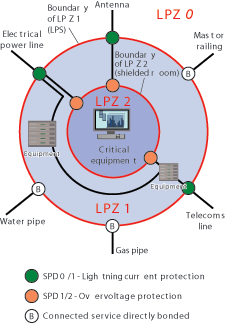What are electrical surges?
Electrical surges, or transient overvoltages, are voltage spikes on power, signal or telecommunications lines that can overload components, leading to failure.
Lightning surges can reach 6,000 V in an electrical installation, with devastating results - even for lightning that strikes up to a kilometre away from the structure! However, surges are also caused by large grid-connected equipment such as motors. When equipment is switched on or off, this creates switching transients that are smaller but more frequent than lightning surges, stressing electronic components. The result is disruption, degradation, damage and downtime.
How are the regulations changing?
There will be important changes in Chapter 44 of the 18th Edition of the IET Wiring Regulations (BS 7671:2018). This is the chapter that covers protection against voltage and electromagnetic disturbances, including protection against transient overvoltages that arise from lightning or switching.
Prior to the 18th Edition, “AQ criteria” was used to determine whether protection against transient overvoltages was required. This accounts for external conditions that influence lightning. However, the AQ criteria method has been removed from the 18th edition.
Instead, electrical contractors will need to ensure that electronic systems are fitted with surge protection devices (SPDs) to protect against transient overvoltages where there may be serious consequences. This include serious injury, loss of life, interruption to public services or commercial activity, damage to cultural heritage, or impact on sites where large numbers of people are gathered.
For all other cases, a simplified risk assessment will determine whether SPDs are required – with the exception being single dwellings in some situations.

High-risk sites such as nuclear or chemical facilities require a full risk assessment, as detailed in BS EN 62305-2.
In general, the 18th Edition of the IET Wiring Regulations requires installation of SPDs in accordance with the BS EN 62305 standard if there is a risk of direct lightning strike to a structure or to the overhead lines connected with the structure.
Changes are also planned to the BS EN and IEC 62305 standards, which cover protection against lightning. The International Electrotechnical Committee (IEC) is planning to publish the third edition of IEC 62305 before the end of 2018. The BS EN version of this is used in the UK and European markets. Its publication is likely to follow the IEC version once CENELEC (the European Committee for Electrotechnical Standardisation) has reviewed the IEC standard and amend it to suit UK and European requirements.
What will electrical contractors need to do?
The result of new wiring regulations is that electrical professionals will need to specify SPDs to protect electronics in mains, signal and telecoms applications in commercial, public and industrial projects. It is important to use suitable SPDs that meet the latest product standards, particularly in terms of safety. This will ensure that they will offer the right protection against repeated “worst case” transients.
Three Types of SPD are available (Types 1, 2 and 3) and these are cumulatively known as a co-ordinated SPD set. There are also Combined Type SPDs (e.g. Type 1+2+3) that handle high surge currents with safe overvoltage protection levels for sensitive equipment. These have technical, practical and economic benefits over multiple single Type SPDs.
Type 1 SPDs should be installed at the service entrance to protect against loss of life or serious injury in the case of a direct lighting strike. They protect against dangerous sparking where the voltage of a surge exceeds the impulse voltage rating of equipment or cable insulation. Another term for Type 1 SPDs is equipotential bonding SPDs and it is important to know that they do not provide any effective protection for sensitive electrical or electronic systems.
As a result, additional Type 2 and Type 3 SPDs are required inside structures that contain electrical and electronic systems. They are overvoltage SPDs that further reduce the size of transient overvoltages to safe levels.
Type 2 SPDs provide overvoltage protection for fixed equipment, whereas Type 3 SPDs are used to protect sensitive or critical loads, particularly against switching transients.